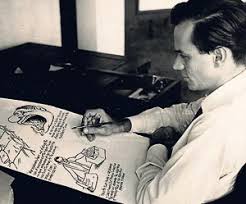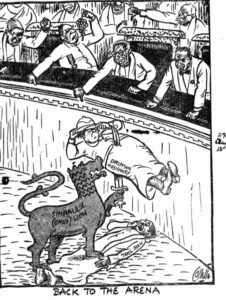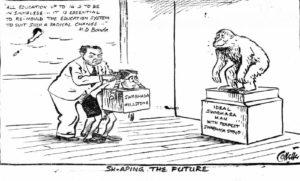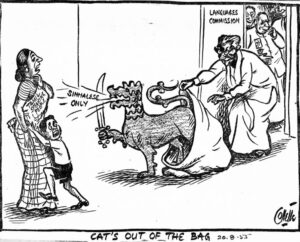by Sachi Sri Kantha, November 3, 2021
I like political cartoons. Nine years ago, in Sept. 15, 2012, I wrote a column entitled, ‘On Sri Lankan Political Cartoonists, stray dogs and hypocrites’ in which I had commented about cartoonists Hasantha Wijenayake and Jiffry Yoonoos.
[https://sangam.org/on-sri-lankan-political-cartoonists-stray-dogs-and-hypocrites/]
Prior to that, in November 2006, I had contributed a book review on ‘Cartoons on J.R. Jayewardene’ [https://sangam.org/taraki/articles/2006/11-06_JR_Cartoons.php?uid=2040] In that review, a Collette cartoon was included depicting Jayewardene as hanging on the tail of the UNP elephant, which was marching for the glory of Buddhism in 1956.

Aubrey Collette (1920-1992)
I continue with my thoughts on Aubrey Collette (1920-1992), who carried the crown of the doyen of cartoonists in post-Independent Ceylon, for nearly 15 years. His sarcastic cartoons of power-holding Sinhalese, Tamil and Muslim politicians of the 1950s have stood the test of time. An entry for Collette, which appears in the digital Lambiek’s Comiclopedia gives the following details.
“Aubrey Collette was born in Ceylon (now Sri Lanka), as the son of a photographer. He was an art teacher for a while, before his political cartoons started appearing in newspapers. The Times of Ceylon and The Ceylon Observer. When the political climate became volatile, he left for Australia in 1961. There his comics and cartoons first appeared in The Bulletin, and later he joined The Australian as an editorial cartoonist. He won the Walkley Award for Best Cartoon in 1970. He moved to Melbourne, where he started working for the Melbourne Herald, but never lost touch with Asia, where his work appeared in magazines such as Asia magazine, The Straits Times and the Ceylon Observer. A popular newspaper comic strip by Aubrey Collette was ‘Sun Tan, the Asian Sensation’.[https://www.lambiek.net/artists/c/collette_aubrey.htm]

(1) Arena show – Collette cartoon, 1958
That sentence in the above profile, “When the political climate became volatile, he left for Australia in 1961” hides more facts than what is currently known. Simply stated, Collette was ‘chased away’ by the thin-skinned minders of Mrs Sirimavo Bandaranaike and her acolytes. The reason: Collette’s cartoons skewering the ‘pious Buddhists’ were too hot for comfort.
Let’s refresh our memories of anti-Tamil and anti-minority political strategies which became entrenched in the 1950s, via Collette’s four cartoons.
Cartoon 1: captioned ‘The Arena show’
Collette depicted the Ceylonese parliament as ‘The Arena’, where the Sinhalese leaders give a ‘thumbs down’ sign, to the ‘Sinhalese (Only) Lion’s ‘circus like’ performance. This ‘Lion’ is holding the Tamil man, under his right fore limb, and at the same time it’s left fore limb that carries a knife which had entered the back and exit through the belly of a Christian missionary.

(2) Swabasha education – M.D.Banda
Cartoon 2: captioned ‘Shaping the Future’
M.D. Banda (1914-1974) was a UNP minister, who once held the Minister of Education portfolio, from 1952 to 1956. His quote that appears on top of the cartoon says, “All education upto 14 std. be in Sinhalese…It is essential to remould the education system to suit such a radical change.” In the cartoon, Banda is being shown hanging a ‘Swabasha millstone’ in the neck of a school boy (who has to stoop with the weight), while he was watching a museum exhibit of an ape. The label for this stooping ape reads ‘Ideal swabhasha man with perfect swabhasha stoop’.
‘Swabhasa’ (literal meaning: self language) is a word that became popular in 1950s, denoting either Sinhalese or Tamil languages. Though UNP was routed in the 1956 election by the ‘Sinhalese-Only’ wave of Mr. Bandaranaike, Banda was lucky to be elected in UNP ticket, mostly because of the pro-Sinhala stand he had promoted during his tenure as the Minister of Education!

(3) Wingless wonder- Collette cartoon
Cartoon 3: captioned ‘Wingless wonder’
While L.H. Mettananda (1894-1967) was considered by Sinhalese as a Buddhist educationist, many Tamils thought of him as a Sinhalese rabble-rowser, for promoting anti-Tamil bigotry in 1956. In this cartoon, Mettananda (as a mother bird) is seen as pushing a Sinhalese boy from his nest in the tree with the words ‘Oh go on! You don’t need wings to fly’. Hardly any text books in Sinhala language were available for students then. What was available in the market and in libraries, were books in English. Collette contrasted this situation, with a boy flying with the wings of ‘English text books’.
Cartoon 4: captioned ‘Cat’s Out of the Bag’
In 1956, then Solomon Bandaranaike government promoted ‘Sinhalese Only’ policy vigorously, thus fueling the fire of ethnic conflict. The government appointed ‘Languages Commission’s’ head opens the bag – from which the proverbial cat (in this context, a lion – representing the Cat’s family) holding a sword comes out roaring ‘Sinhalese Only’. This act frightens the Tamil speaking people, represented by a woman and her son.

4) ‘Sinhalese Only’ Lion, 1955 Aug 20, 1955
Coda
In the then Ceylon, by belonging to the minority Burgher ethnic group, Collette was able to comprehend the anxieties and humiliations of a minority group suffocating under the regime of an aggressive majority group, far better than to one belonging to the Sinhalese ethnics. ‘Burghers’ was a generic term for the descendants of polyglot European community (predominantly Portuguese, Dutch and British), who had married either amongst themselves or taken spouses from native Sinhala or Tamil ethnics. An year after Collette’s birth (Sept 5, 1920), the number of Burghers & Eurasians residing in Ceylon amounted to only 20, 926 in the 1921 Census. After emigration to Australia in 1961 at the age of 40, Collette lived for another 30 years and died on January 8, 1992. The number of Burghers in the land, Collette left behind, was recorded as ‘no more than 30,000’ in a New York Times report of Dec. 27, 1988 by Barbara Crossette.
It may not be far from the truth to assert, that the origins of Liberation Tigers of Tamil Eelam (LTTE) in 1976 has to be traced 20 years earlier to the racist policies instituted by the Bandaranaike couple’s pro-Sinhala Buddhist, racist regimes from 1956 to 1964, as depicted in Collette’s periodic cartoons of that era. The current composition and recruitment to the Sri Lankan armed forces (comprising of only Sinhala-Buddhist population) is a stark fact in this regard.
Sources:
Barbara Crossette: Colombo Journal – A proud people, scattered and forgotten by time. New York Times, Dec 27, 1988.
Wasantha Siriwardena: The Bad Old days via satirical cartoon – Aubrey Collette’s touch. Thuppahi’s Blog [of Prof. Michael Roberts], May 18, 2016.
https://thuppahis.com/2016/05/18/the-bad-old-days-via-satirical-cartoon-aubrey-colletter-touch/
Neville Weereratne: Collette’s cullings – The satirist’s fine line. Chapter 9, 43 Group – A Chronicle of Fifty Years in the Art of Sri Lanka.
https://www.43group.org/chapters/chapter-9-collettes-cullings.html
*****